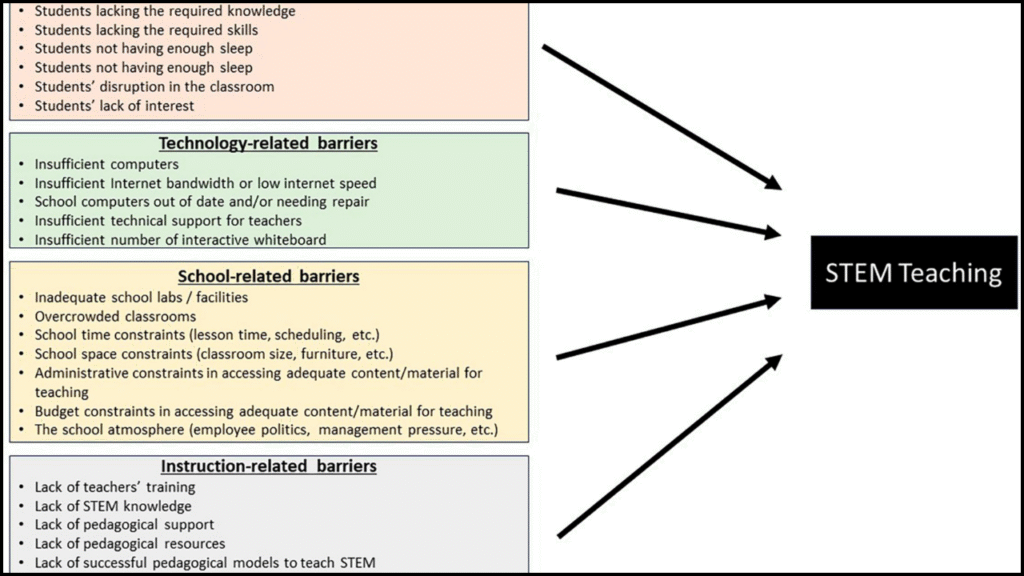
Access to undergraduate research opportunities plays an essential role in shaping the academic and professional development of STEM students. Research engagement provides exposure to critical thinking, practical application of theories, and preparation for advanced studies or careers. However, barriers continue to restrict participation for many students. These barriers are often systemic, institutional, financial, or related to mentorship and awareness.
A systematic review of these challenges highlights patterns across institutions, reveals inequalities in access, and provides insights into potential solutions. The following discussion explores the various obstacles STEM undergraduates face while trying to engage in research opportunities, presenting findings in detail with structured points and comparative insights.
Table of Contents
Overview: Barriers to STEM Undergraduate Research
| Category of Barrier | Key Challenges | Impact on Students |
|---|---|---|
| Institutional Barriers | Limited availability of research programs, competitive selection processes, lack of funding for undergraduate projects | Reduced participation rates and unequal access |
| Faculty and Mentorship Barriers | Lack of mentor availability, faculty preference for graduate students, and inconsistent mentorship quality | Limited guidance and inadequate skill development |
| Financial Barriers | Unpaid research roles, inability to balance part-time jobs with research demands | Exclusion of low-income students from research experiences |
| Awareness Barriers | Poor communication of opportunities, unclear application processes | Missed chances due to a lack of knowledge |
| Cultural and Social Barriers | Gender bias, underrepresentation of minorities, and limited encouragement for first-generation students | Reinforcement of inequities in STEM participation |
| Academic Preparedness Barriers | Lack of prerequisite skills, heavy coursework loads, and limited lab experience | Struggles with readiness and confidence |
| Time-Related Barriers | Conflict with class schedules, limited summer options, and long-term commitments | Inability to sustain research participation |
Institutional Barriers
- Limited Program Capacity
- Many universities restrict the number of available research slots due to budget or faculty limitations.
- Highly competitive selection processes often favor top-performing students, leaving average performers without access despite interest.
- Unequal Distribution of Opportunities
- Research-intensive institutions typically provide more options, while smaller colleges may lack dedicated undergraduate research programs.
- STEM majors with higher departmental funding, such as engineering, often enjoy more opportunities compared to fields like environmental science or mathematics.
- Impact on Students
- Students from underfunded institutions or programs experience limited exposure, which affects graduate school applications and career development.
Faculty and Mentorship Barriers
- Mentor Availability
- Faculty members often prioritize graduate students over undergraduates due to the complexity of projects and publication demands.
- Undergraduate students may receive minimal supervision, leading to dissatisfaction and disengagement.
- Quality of Mentorship
- Inconsistent mentoring styles create challenges, with some students receiving structured guidance while others face neglect.
- Lack of training for faculty in mentoring undergraduates further reduces the effectiveness of research experiences.
- Impact on Students
- Students without proper mentorship fail to develop confidence, research skills, and strong recommendation letters.
Financial Barriers
- Unpaid Research Positions
- Many undergraduate research opportunities remain unpaid, disproportionately affecting students from lower-income families.
- Students balancing jobs for financial survival cannot afford to spend long hours in unpaid research roles.
- High Costs of Participation
- Travel expenses for fieldwork, conferences, and lab materials add an extra financial burden.
- Students without financial aid or stipends may opt out, despite strong interest.
- Impact on Students
- Financially disadvantaged students face exclusion, perpetuating socioeconomic inequalities in STEM research participation.
Awareness Barriers
- Communication Gaps
- Information about research openings is often shared informally through faculty networks, excluding students without direct connections.
- Universities may lack centralized platforms to announce opportunities, leaving students unaware.
- Application Challenges
- Vague requirements and unclear deadlines create confusion.
- First-generation students often lack guidance on how to approach faculty for research positions.
- Impact on Students
- Students miss valuable opportunities due to a lack of awareness, even when they have the required interest and ability.
Cultural and Social Barriers
- Gender Inequalities
- Female students in STEM report facing biases when applying for research positions, especially in male-dominated fields such as physics and engineering.
- Subtle discouragement, lack of role models, and stereotyping affect their confidence.
- Underrepresentation of Minorities
- Minority students, especially from racial and ethnic groups underrepresented in STEM, encounter fewer invitations to participate in faculty-led projects.
- Language barriers for international students add another layer of exclusion.
- First-Generation Student Challenges
- Students without family backgrounds in higher education often lack the cultural capital to navigate research systems.
- Impact on Students
- Social inequalities in STEM become reinforced, resulting in a homogeneous research community.
Academic Preparedness Barriers
- Skill Gaps
- Many undergraduates lack the technical or analytical skills required to contribute effectively to research projects.
- Weak backgrounds in statistics, programming, or lab techniques limit participation.
- Heavy Course Loads
- Intense coursework schedules leave little time for additional commitments like research.
- Students in demanding majors may struggle to balance academics and research work.
- Impact on Students
- Lack of preparedness reduces confidence and discourages long-term involvement in research.
Time-Related Barriers
- Schedule Conflicts
- Fixed class schedules often overlap with lab timings or research activities.
- Opportunities requiring full-time summer commitments may exclude students with family or work responsibilities.
- Sustainability of Commitment
- Long-term projects require consistency, but students juggling multiple priorities often withdraw.
- Impact on Students
- Research participation becomes an option only for those with flexible schedules, disadvantaging students with external obligations.
Comparative Insights: Students Most Affected
| Barrier Type | Most Affected Groups | Examples of Impact |
|---|---|---|
| Institutional | Students at small colleges | Few formal research programs |
| Faculty/Mentorship | Undergraduates in graduate-heavy labs | Preference for graduate assistants |
| Financial | Low-income students | Inability to join unpaid roles |
| Awareness | First-generation students | Lack of knowledge about processes |
| Cultural/Social | Women and minority groups | Gender bias and underrepresentation |
| Academic Preparedness | Students from under-resourced schools | Lack of prerequisite skills |
| Time-Related | Students with part-time jobs | Conflicts with schedules |
Strategies to Address Barriers
- Institutional Solutions
- Expansion of structured undergraduate research programs across all STEM departments.
- Allocation of funding specifically for undergraduate participation.
- Mentorship Improvements
- Training programs for faculty to develop mentorship skills.
- Peer-mentorship networks where advanced undergraduates support newcomers.
- Financial Support
- Paid research assistantships to ensure inclusivity.
- Travel grants and stipends to reduce financial strain.
- Awareness Measures
- Centralized platforms listing all research opportunities with clear instructions.
- Workshops guiding students on how to approach faculty for positions.
- Cultural Change
- Diversity initiatives to encourage women, minorities, and first-generation students.
- Visible role models and mentorship programs tailored for underrepresented groups.
- Academic Preparedness
- Integration of research skill courses into early undergraduate curricula.
- Bridge programs to train students in lab and technical skills before joining projects.
- Time Management Support
- Flexible research models, such as short-term or modular projects.
- Hybrid research opportunities combining online and in-person work.
End Notes
Undergraduate research serves as a cornerstone of STEM education, yet significant barriers limit access for many students. Institutional limitations, lack of mentorship, financial constraints, and cultural inequities all contribute to unequal opportunities. Addressing these challenges requires systemic reforms, inclusive policies, and proactive mentorship. A more equitable research landscape will not only empower students from diverse backgrounds but also strengthen the future of STEM by cultivating a broader, more inclusive community of researchers.

